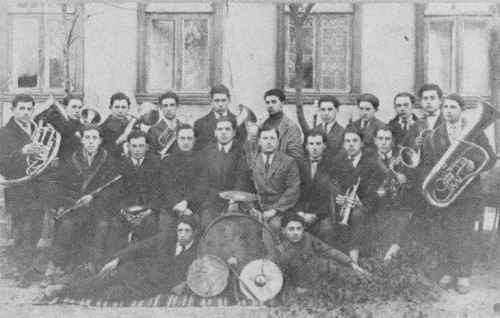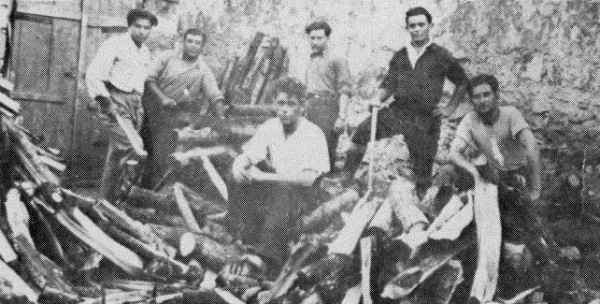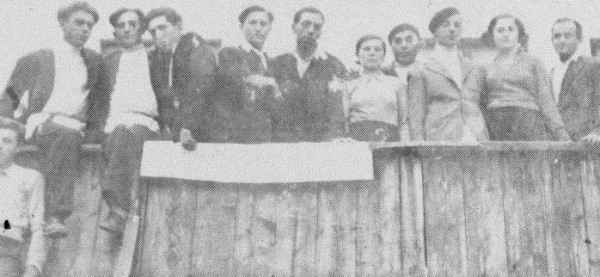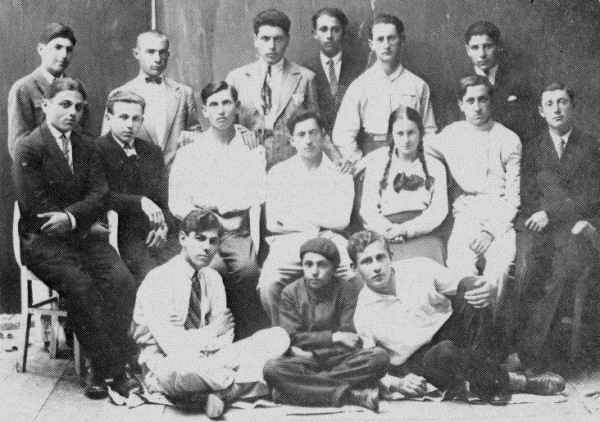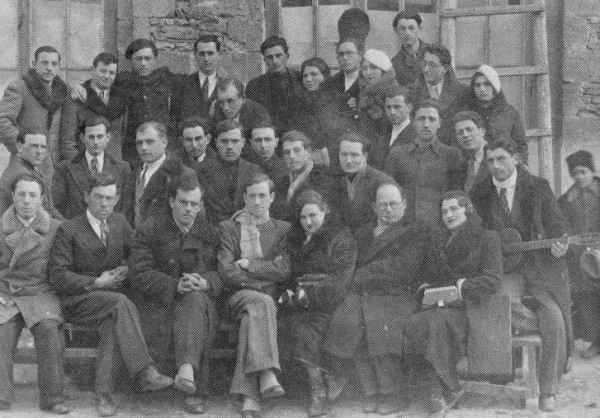[Page 321]
Tatarbunar
Tatarbunar
(Tatarbunary, Ukraine)
45°51' 29°37'
Translated by Yocheved Klausner
This town does not have a long history. It was founded in 1809, and in 1861 it was registered by the general statistical authority as a town in the Bessarabia region. As anti–Semitism grew in Russia, the Bessarabia District Management decided in 1882 that Tatarbunar was a village, not a town. The significance of this decision was that the temporary decrees that prohibited Jews to live within a certain distance (50 Verstas) from the border applied to Tatarbunar as well and the Jews living in this “village” should expect to be deported. All attempts to change the decree failed – and several Jewish families, who had lived tens of years in Tatarbunar, were deported. Only in 1890 did the Senate decide, after discussing the Jewish plea, to annul the decree of the District management and return to Tatarbunar the status of town.
From various articles that were published in the press in the 80's of the 19th century we learn about the life and activity of the Jews in town. In Hatzefira, issue 9 1882 we read about the Hachnasat Orchim Society [free accommodation for guests, lit. “Welcoming guests”] “that rented a beautiful house and furnished it with beds and tables, and appointed a devoted man to take care of the needs of the house.” It seems that this activity was well suited within the framework of other activities of this kind, organized by the Jewish intelligentsia in town and aimed to establish modern charity institutions, free of the influence of “attendants” of various kinds.
In a report published in a local newspaper (issue 20, 1882) we read about organizing an Association for Aliya and Settlement in Eretz Israel, with 100 registered members, each paying 100 Rubles. However, issue #23 of the same newspaper published a slight “correction:” not 100 registered members, but 20, and they did not bring any income. The Association wanted to send delegates to Eretz Israel to buy land, and for this purpose it got in touch with the Central Committee of the Associations for Settlement in Eretz Israel that was active in Romania (the main offices were situated in Galați), and received a report expressing “a good opinion” about Eretz Israel. The Association turned to Sir Olifant asking support and he replied, that the money of the London Committee for the support of Jewish refugees from Russia is designated for those who immigrate to America; the Turkish Sultan, for political reasons, prohibited the Jews to immigrate to Eretz Israel, and “until Olifant and other activists succeeded in changing the Sultan's mind, the Jews should be patient.”
We know from another source about another association that was formed that year, to help and support needy Jews. The founders were 19 young men from the town, who collected a considerable sum to help poor families to make Aliya, but this association did not last long.
Some reports from 1898 said that the Zionist Association in Tatarbunar sold shekalim and passed the proceeds to the Zionist management.
That year, the association Dorshey–Zion held a grand Chanuka ball with the participation of more than 200 people.
A delegate from Tatarbunar participated in the Zionist meeting in Warsaw, which took place after the Second Zionist Congress, and another delegate from Tatarbunar participated in the Regional meeting held in Kishinev, as preparation for the Third Zionist Congress.
The Nes–Ziona Association in Tatarbunar sent a congratulations letter, in the form of a poem, to the Second Zionist Congress and to the most honored chairman Mr. Theodore Herzl, signed by 20 Tatarbunar Zionists.
The Central Zionist Archives keeps a letter from the Zokhrei–Zion Association in Tatarbunar to Dr. Herzl, announcing that he was elected by the Association as delegate to the 4th Zionist Congress; the Association grants him the authority to pass the mandate to whom he saw fit. The letter is dated 8 July 1900, and the Jewish date, mentioning the weekly Torah Portion, is added. The letter is signed by the chairman Chaim Glickman, his deputy Avraham Greenberg and the secretary Zvi Silberman.
In 1902, the Congress of the Russian Zionists took place in Minsk, and the Zionist Associations that had sold Shekalim had the right to send delegates. The Tatarbunar Zionists received that right and sent a delegate. After the congress, an intensive Zionist activity began in Bessarabia and many JNF [Keren Kayemet] stamps were sold. The Tatarbunar Zionists ordered stamps for 26 Rubles.
The threat to the Zionist Movement posed by the Uganda dispute caused distress to the Tatarbunar Zionists, and when they found out that at the meeting of the Great Executive Committee in Vienna (April 1904) an agreement was reached between the “Zionists of Zion” and Herzl – the Zokhrei–Zion Association in Tatarbunar sent a letter of appreciation and encouragement to Dr. Herzl.
(From the book on Bessarabia by A. Feldman)
[Page 322]
Tatarbunar and its Jews
by Binyamin Gieker
Translated by Yocheved Klausner
The general Population of Tatarbunar (the meaning of the name – a Tatar water source, hinting at the many sweet water springs in the region) was 15,000 souls, including 520 Jewish families. Most of the Jewish families lived in the center of town and their occupations were commerce and crafts. The institutions that served the Jewish population were The Jewish Community Committee and the Association for Helping the Needy, headed by Nushka Weissman. At the end of 1920, by the initiative of Dr. Wollman, a bank was founded, mainly for the purpose of giving loans to those of limited means. Two synagogues served the religious population in town, and they were enough, since the Jewish population in town was not particularly religious. There was, however, an intensive and lively cultural activity in town, especially theatrical activity, led by Ita Wilk, Zvi and Ita Albert and others. The local performances of the Jewish theater attracted a large public.
Several young people opened a library in a small room in the house of Pinya Feigin; in time it turned into a large and beautiful library in a new building, and became a cultural center of the town.
The youth in Tatarbunar
The young people of Tatarbunar have grown up in the shadow of WWII, the Russian revolution and the transition from Russian to Romanian rule. These events have undoubtedly left their marks on the development of the young people.
|
|
Leaders and public activists
Sitting on the floor, from right to left: Rosa Tzvoter, Liuba Brodeski, Sofa Weissman, Riva Silberman, Yosef Silberman, Bluma Silberman
Second row sitting, from right to left: Nushka Weissman, in back of him Mrs. Weissman, Dr. Fischman, Sara Midovoy, Hirsch Silberman, Mrs. Teitelbaum, Tona Teitelbaum, Akiva Brodeski, Yosef Litvin, Zvi Albert
Standing: Dr. Wollman, Riva Wilk, Mrs. Tzobotar, Gardintchik, Mrs. Gardintchik, Dr. Komorovski, Isak Wilk, Mrs. Slotzki, Mrs. Litvin, Wilik, Mrs. Wilik. |
[Page 325]
The Tatarbunar Gordonia Branch
by Arie Shochat
Translated by Yocheved Klausner
The first steps to organize Zionist youth activity in our town were taken after the Balfour Declaration. Some 20 young people formed a small organization with the purpose of making Aliya to Eretz Israel. Indeed in 1920–1921 most of them went to Eretz Israel, but after that there was a period of about 7 years of low activity in this area. There was no initiative to organize young Zionists, the main Zionist activity in town being contributions to Keren Kayemet (JNF) and Keren Hayesod.
In 1929, after the riots in Eretz Israel, a group of friends, headed by Yitzhak Goldman, Arie Shochat (Leibl), Yosef Silberman, Yosef Specterman, Israel Gieker, Riva Silberman and Fania Gardentzik began organizing young local people aiming to establish a framework for their Zionist education and personal development. With the help of the Akkerman Gordonia they established a Gordonia branch in Tatarbunar. Most of the members came from the working youth who, due to the economic difficulties at home were forced to interrupt their studies and start working at a young age. For them, the Gordonia branch was a study place as well, and there they completed their education, expanded their knowledge in the history of the Jewish people, learned the Hebrew language etc. The Community provided Gordonia with a location for its activity, and the members worked at collecting money for the Zionist Funds.
|
|
| A group of Zionists at Hakcshara [training camp] in Orchayov |
|
|
| A group in training (Orchayov), among them people from Tatarbunar |
[Page 326]
|
|
| Members of Gordonia, “graduated” in 1931 |
|
|
| The “Boselia” branch in Tatarbunar |
This material is made available by JewishGen, Inc.
and the Yizkor Book Project for the purpose of
fulfilling our
mission of disseminating information about the Holocaust and
destroyed Jewish communities.
This material may not be copied,
sold or bartered without JewishGen, Inc.'s permission. Rights may be
reserved by the copyright holder.
JewishGen, Inc. makes no representations regarding the accuracy of
the translation. The reader may wish to refer to the original material
for verification.
JewishGen is not responsible for inaccuracies or omissions in the original work and cannot rewrite or edit the text to correct inaccuracies and/or omissions.
Our mission is to produce a translation of the original work and we cannot verify the accuracy of statements or alter facts cited.
 Bilhorod-Dnistrovs'kyy (Akkerman), Ukraine
Bilhorod-Dnistrovs'kyy (Akkerman), Ukraine
 Yizkor Book Project
Yizkor Book Project
 JewishGen Home Page
JewishGen Home Page
Yizkor Book Director, Lance Ackerfeld
This web page created by Max Jason Hallgarten
Copyright © 1999-2026 by JewishGen, Inc.
Updated 10 Jul 2018 by JH
